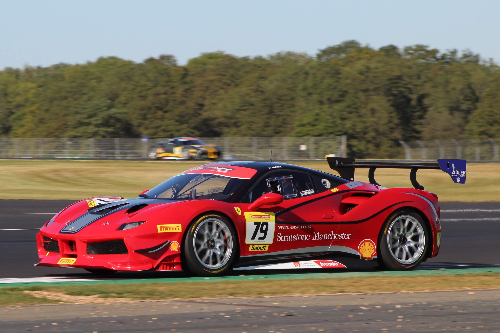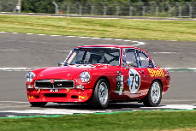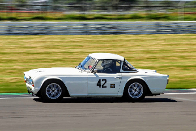50 years ago, in the presence of the late William Heynes (Jaguar’s Engineering Director), Jim Eastick (a member of Jaguar’s Experimental Engine Department) started their new No.1 prototype V12 quad-cam engine for the first time.
This was Jaguar’s first V12 production/race engine and it carried Jaguar’s hopes of a return to Le Mans and a chance of re-living their glory days of the 1950’s.
On Thursday, 30th November 2014, Jim Eastick started their No.2 prototype V12 quad-cam engine in the presence of Jonathan Heynes (son of William Heynes). This was the first time this engine had been heard in over 45 years.
The event was witnessed by members of the original team who had worked on this engine as well as those who had worked on building the car which was to take this engine to the racetrack – Jaguar’s legendary one-and-only Le Mans Prototype XJ13.
Those present included Richard Hassan (son of Jaguar’s Walter Hassan), Peter Wilson (author and ex-Jaguar Competition Department), Frank Philpott (ex-Jaguar Experimental Engine Department), Peter Jones (ex-Jaguar Competition Department), Brian Martin (ex-Jaguar Electrical Engineer) and Nigel Boycott (ex-Jaguar Service and Engine Department).
Also present were suppliers, friends and fellow Jaguar enthusiasts invited by Neville Swales to share this first milestone in his dream to install this unique engine in an exact recreation of Jaguar’s 1966 XJ13 Le Mans Prototype.
BACKGROUND
In July of 1964, Jaguar began assembly of the first in a series of quad-cam prototype V12 engines. Whilst Jaguar’s earlier 6-cylinder XK engine had been designed primarily with road-use in mind, this new V12 was aimed firmly and squarely at the racetrack and a return to Jaguar’s glory days at Le Mans.
On the 1st December 1964 Jaguar began assembly of a second quad-cam prototype V12 engine which would be used to investigate the feasibility of using this race-engine in one of their road cars.
In the end, only six engines were assembled. Today, there are only three complete running engines in existence. One of these remains with Jaguar (they also own parts of the engine originally installed in the XJ13 in 1966), a second was built up from a collection of new and used parts (assorted components which never progressed beyond the test-bed in period) and a third which miraculously survived as a complete engine – complete and intact from the day it last ran on Jaguar’s test-bed at the end of 1969.
It was the acquisition of this complete engine in 2010 by Neville Swales which inspired him to recreate Jaguar’s one-and-only XJ13. Not simply a copy of the car crowning Jaguar Heritage’s collection, but as it was in 1966/67 during active development and when hopes were still alive for a return to Le Mans. In the end, and for a variety of reasons, only one car was built and the car never turned a wheel in anger, although its latent potential was evident very early on when it broke the UK closed-lap record in the hands of its main test and development driver David Hobbs. This record stood for the next 32 years and was only beaten in 1999 by the McLaren F1 by just over 6mph.
In 1967 the XJ13 was pushed into a quiet corner of Jaguar’s Competition Department and left to gather dust.
THE PROJECT
The car was wheeled out again in 1971 only to be heavily crashed during an event to promote their forthcoming SOHC V12-powered Series 3 E-Type. The driver was Jaguar’s legendary Norman Dewis. Although Norman’s quick reflexes meant he survived unscathed, the car was badly damaged. It was eventually re-built and re-bodied using most of the original components but in a form altered from the original – a form more suited to its intended future role as a demo vehicle.
Having acquired the surviving second engine, Neville Swales decided he would recreate Jaguar’s XJ13 as it looked during its active development and as a tribute to the genius of its Designer – Malcolm Sayer. Almost 4 years of meticulous research and study has left Neville with a unique collection of original documents, photographs and data which gave him the information needed to accurately recreate the car. Although there were never any “blueprints” for the original car, Neville has succeeded in piecing together original and unique base working data (much of it originating from Malcolm Sayer and others involved in the project) which means he is probably the only person now in a position to accurately recreate the 1966 car – a car which no longer exists in its original form.
STARTUP
The day began with people arriving from far and wide. Visitors from the Netherlands, Germany, Finland and many parts of the UK assembled to share this first milestone in Neville’s project and to help celebrate those people involved in Jaguar’s XJ13 project and its mighty quad-cam engin
After a brief introduction by Neville, Peter Wilson presented a fascinating summary of Jaguar’s project and introduced both Jim Eastick and Frank Philpott who each described their roles in the project.
Neville then introduced Jonathan Heynes who gave some very interesting insights into the project.
The stage was then set to waken the engine from its 45-year slumber. Jim Eastick took his position by the starter button. Onlookers waited in anticipation with cameras poised. The engine awoke at Jim’s first press of the starter and soon all 12 cylinders were spitting and clearing their throats in unison as Jim expertly passed his hands over the engine checking that all injectors were feeding fuel as required.
The engine did seem a little grumpy at being woken from such a long slumber but very quickly roared at us as it was provoked into full song. A bark and deep-throated roar, which had not been heard for 45 years, rent the air as the throttle was opened.
The engine was awake and ready to play its part in the next milestone after being united with Neville’s 1966 Jaguar XJ13 “toolroom copy”.
SHARE THE DREAM
Those who were unable to be present but who wish to experience the sound made by this engine are invited by Neville to join him in his personal blog – http://www.XJ13.eu – where project progress is charted. You will find a sound-clip recorded of the engine’s awakening.
The journey begins!
Source. Neville Swales






Discussion
No comments yet.